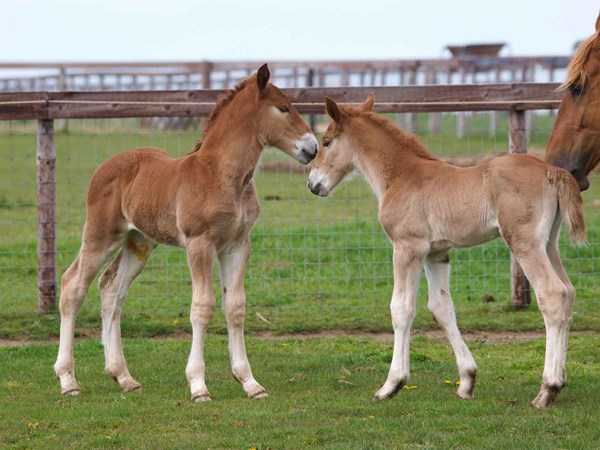 Credit: Thinkstock
Credit: ThinkstockOne big concern with growing horses is the occurrence of developmental orthopedic disease (DOD), which is a broad term that describes a variety of musculoskeletal problems that arise in a young, growing horse. Those can include angular limb deformities, flexural limb deformities, osteochondrosis, physitis and Wobbler syndrome.
From conception to birth, nutrition of the broodmare is important to the growing fetus and can affect the outcome of DOD in young horses. A balanced ration with respect to energy and minerals is critical to feed the gestating mare. Mare’s milk is a poor source of trace minerals, so for several months following birth, a young foal is dependent on liver mineral stores, such as copper obtained through mare nutrition and accumulated by the fetus during the last trimester. While a foal’s liver store of copper has no influence on the incidence of DOD, it can play a role in improvement and repair of DOD lesions that might occur.
Musculoskeletal growth is not a steady continuum, but rather a series of differential growth “spurts,” growth occurring more like a ratcheted pattern than a smooth curve. Challenges in management occur most often during these phases of more rapid or aggressive growth when DOD is most likely to occur.
Excess Energy Intake
Dietary control of the mare post-foaling is important to control milk production for the nursing foal–excess consumption of rich milk prompts growth spurts. Usually, 100% of a foal’s nutrition is met through mare’s milk for the first 2-3 months. A young foal showing signs of DOD might need to be weaned as early as three months of age (rather than the typical 4-6 month weaning age) to control energy intake. Restriction of energy intake can slow a young horse’s growth rate.
The risk of OCD increases when a young horse is fed too much energy. Excessive feeding is considered a bigger culprit than inadequate feeding–excess calories and energy have been linked to young horses that acquire or “develop” DOD lesions. Caloric intake is a critical consideration, more so than protein concentration. Studies have not identified any problem with feeding high levels of protein; adequate protein (14-16% of the foal’s total diet) is important for proper bone development. Protein restricted to less than 12% has been correlated with reduced growth rates and poor mineralization. Most importantly, excessive energy can “fuel” excessive growth and subsequent abnormalities associated with improper endochondral ossification of joint cartilage. The prime objective for managing the growing foal is to achieve moderate and steady growth.
Not only do erratic growth spurts increase the risk of DOD, but also compensatory growth spurts add risk. This applies to a foal whose growth might be delayed due to a bout of illness, then when recovered, growth takes off rapidly again. It is critical to monitor a growing foal’s average daily gain; there won’t necessarily be consistent poundage gain every day or every week. The situation to avoid is one that underfeeds one week and overfeeds the next, creating a yo-yo effect of growth slow-down and then spurts.
Solid Food Intake
A foal begins to sample the mare’s food within a couple of weeks of age, so whatever feed she receives will affect the foal, potentially leading to nutritional imbalances that are inappropriate for growth.
Creep feeding–providing a special feeder with narrowly spaced bars that restrict the mare’s muzzle or in a location that the foal can access but the mare cannot–is a technique to provide nutritional supplements to a foal. It is recommended to offer growth-formulated grain/pellet supplements in the amount of ½-3/4 pound of feed per month of age, beginning at 1-2 months. Provision of steady, balanced nutrition minimizes the tendency for growth spurts. By weaning time (4-6 months), a foal will likely be consuming ¾ pound of growth-formulated supplement for every 100 pounds of body weight. There are different formulations available depending on whether grass or alfalfa hay is fed.
Mineral Balance
In addition, mineral balance is critical–proper balance of calcium-phosphorus ratios and attention to copper-zinc ratios are important for proper musculoskeletal development. Copper is necessary for mineralization of the cartilage matrix and bone development. Good quality roughage–a 50:50 mixture of grass and legume hay works well–can be supplemented with as much growth-formulated concentrate as necessary to maintain a foal with an excellent body condition score. The ribs should be felt but not seen, with the foal neither too thin nor too fat. Trace mineral blocks don’t provide calcium or phosphorus, and there is no guarantee that a young horse will consume sufficient amounts. Therefore, a balanced mineral ration is an essential part of dietary needs for a growing foal. Hay and pasture nutrient analysis help to develop a dietary plan with an appropriate mineral supplement that compensates for forage deficiencies.
Feed is best formulated and provided based on the individual growing horse with adjustments made to minimize nutrient gaps; group feeding of foals increases the risk of DOD.


